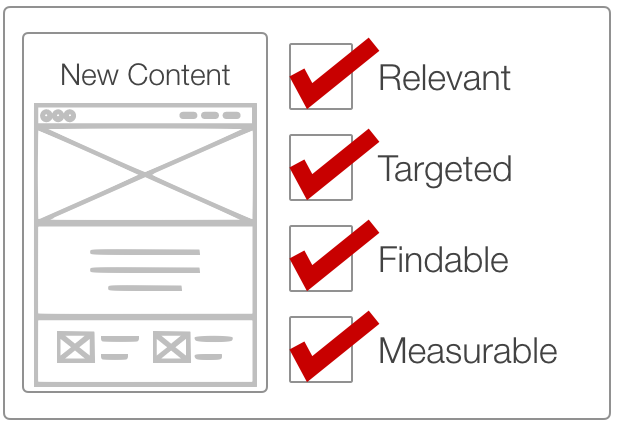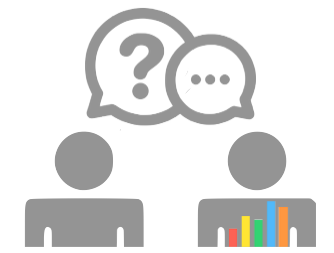Who do you have in mind when you create content? We all like to imagine we’re creating content for our audiences, but do we really know who our audiences are? Even if we think we know our audiences, are we actually creating content that matches their intent? Creating personas and delivering the right content to engage the right people with your brand is a combination of art, science, and the right data.
You are not your audience
Even if you have a lot in common with the people you’re communicating with, the very fact that you’re offering a solution means that you’re no longer a part of the cohort group. By definition, you’ve stopped asking the same questions and you have different pain points.
Now that you aren’t a typical consumer of your own product, you’ve introduced a level of bias and the possibility that the judgment calls you make on your audience’s behalf are flawed.
“The Golden Rule is treating others how you want to be treated and the Platinum Rule is to treat people how they want to be treated. To do that, you need to know how they want to be treated. To know how they want to be treated, you need data that tells you about their habits, preferences, and interactions,” suggests Erin Robbins O’Brien, President at GinzaMetrics.
Getting to know your audience means understanding their positive interactions as well as their negative ones. Creating negative personas helps form a picture of those people who are in the realm of your audience, but aren’t engaging with your brand. Knowing their unique traits and the reasons why your content has not interested them to date will help you craft specific messages designed to attract them to your brand.
Use search data to get to know your audience
When marketers embark on the journey to create audience personas, search data is often overlooked, or at least not the first place we look for audience insights. Search data should be a key component to our persona development because search data allows us to understand how audiences are actually talking about products and services natively. Search data gives us the ability to track the actual words and phrases audiences are using when they’re looking for solutions to their problems without the prompts of paid advertising and other marketing efforts.
Search data allows you to take a deeper dive into:
- The language audiences are using.
- Specific words and phrases
- Changing words and phrases
- Where the search originates.
- Geography
- Type of device
- Which social channels your audiences prefer.
- What’s working for your competitors.
- Mediums
- Messages
- Methods
Search data provides a certain granularity of audience preferences not available through other types of data. For instance, you can see how each of your persona groups uses keywords and descriptions differently for the same features or services.
Vocabulary and terminology differences may vary across persona group attributes including:
- Geographical regions
- Ages
- Income level
- Roles
- Industry
According to Erin, “When you know the different ways people are describing your product and services and what content they’re consuming, you can design better outreach on paid efforts, optimize better social messages, and create better content for search.”

Understanding the search preferences of your persona groups can help you to not only create better content, but also distribute it in a way that’s more likely to engage your target audiences. Search preferences will help you determine persona behavioral traits, including:
- Device type
- Mobile
- Desktop
- Marketing channel
- Social media
- Content type
- Video
- Podcast
- Blog post
- EBook
- Infographic
Your personas are more than current customer profiles
Historically, audience persona profiles have relied heavily on the traits of current customers. The practice is understandable, given the amount of data available when marketers first starting thinking about their audiences as groups of individuals with different needs and desires. Now, relying only on personality traits of those who have already bought your product or signed up to use your service is dangerously close to being completely ineffective and unnecessary, given the amount of data now available to inform persona development.
If you’re creating persona profiles based on the people who are already taking the actions you want them to take, you’re missing out on identifying and targeting audiences who should be engaging with your brand, but aren’t. To understand why certain audiences aren’t completing the buyer journey, create negative personas for those people who came close to becoming customers, but didn’t buy your product or service.
In addition, relying on the habits and preferences of current customers to inform your persona development may mean that you’re only looking at the person who made the final buying decision and ignoring the people who influenced that decision. Before the purchase was made by the C-suite executive who now populates your customer list, someone else in the organization probably provided research and recommendations. Influencer personas represent the audience who is first identifying the problems and challenges and then looking for ways to solve them.
Use search data to gather information about who is influencing the final decision. Find out what they’re searching for, how they’re searching for it, and the content they’re actually engaging with when they search. When you’re looking at audience engagement, you’ll want to see who is choosing your competitors and analyze the types of people who are picking other players in your market.
Some things to consider when looking at the audiences your competitors are attracting:
- How do these personas differ from yours?
- Location
- Shopping/purchasing preferences
- Personal traits
- Industry
- Title/position
- Other persona traits
- How does competitor content differ from yours?
- Medium – what types of content are attracting potential audiences?
- Method – what channels are competitors using?
- Message – what are competitors saying?
“When we’re talking about creating personas, we need to know who is already engaging with us, but also how it was that things went wrong or didn’t work with our missed opportunities. Either we aren’t listening very well or we’re focusing on audiences who aren’t very compatible with us and we need to shift our view and expectations,” advises Erin.
Understanding the vocabulary of your audience
If you travel outside your native region of the United States and you don’t understand the colloquialisms and social norms for specific situations, you’re open to responding in a completely inappropriate way and looking out of place. This same concept rings true when you’re creating messaging for your audience. In order to build trust and create a connection, you’ll need to understand how people describe things and what responses they expect. Language differences may vary depending on a variety of factors including region, age, education level, economic status, etc.
Vocabulary choices might be one of the most significant insights you can have into your audience. Use the same words and phrases as your target audience to optimize content to mirror how they’re looking for information or solutions. Search vocabulary should also be used to optimize your paid opportunities for the words and phrases that will most readily connect with your target audiences.
When you create content that matches how your audiences what to be spoken to and uses their own linguistic patterns, they’re much more likely to convert and they’re much more likely to click on your content first.

Consider the vocabulary of your audience in your paid efforts and social media posts and use the words, phrases, and terms that people are already looking for to get your content or to get to your competitor’s content. Discover how competitors are attracting your potential audiences and take traffic from them.
Erin recommends using audience vocabulary to inform all marketing efforts. “One size does not fit all when it comes to creating content, creating media, creating social posts, even e-mail subject lines. I would recommend varying email subject lines by persona group and then making very small tweaks based on how they converse natively on both social and search.”
How many personas in your community?
Creating hundreds of personas for your brand can be a mistake. Limiting the number of personas you want to market to makes the process more manageable and allows you to actually create content with those personas in mind.
If you haven’t started creating personas yet, start with two or three. Once you’ve identified them, it will be easier to target them for messaging and for measurement. As you get to know your audiences you may want to identify sub-groups within larger persona groups without over-identifying too many target audiences. Group personas by their commonalities to create a manageable number of audiences for content creation and then divide them up by their differences to measure how well your messaging is working.
There’s nothing wrong with collecting granular data and understanding the specific preferences of lots of people within a persona group but for most of us, we won’t be marketing to each one of them individually. The one exception would be organizations with enough data and enough resources to provide truly personalized content to specific individuals.
Audience personas are a tool marketers use to ensure that the content we create will attract, engage, convert, and delight our audiences. Although personas are not living, breathing people, but rather a conglomeration of traits and preferences, the likes and dislikes, preferences, vocabulary, and search practices of our personas should put a face on the people who will be clicking, or not, on our content, social media posts, or paid advertising slogans. Talk to them as though they are real to show empathy and create trust and engagement.

